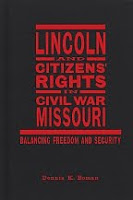* Captain Joseph Boyce and the 1st Missouri Infantry, CSA
* Price's Lost Campaign: The 1864 Invasion of Missouri
* Spain and the American Civil War
* Demon of the Lost Cause: Sherman and Civil War History
 With a civilian populace significantly divided in allegiance and much of its territory under uninterrupted Union control beginning in early 1862, the tidewater section of the state of North Carolina has proven to be a useful laboratory for the scholarly study of the social and political ramifications of Union occupation. The result of historian Judkin Browning's investigation into the dramatic shift away from pro-Union sentiment among many loyal residents of the towns of New Bern and Beaufort by the end of the Civil War is the fine new book Shifting Loyalties: The Union Occupation of Eastern North Carolina.
With a civilian populace significantly divided in allegiance and much of its territory under uninterrupted Union control beginning in early 1862, the tidewater section of the state of North Carolina has proven to be a useful laboratory for the scholarly study of the social and political ramifications of Union occupation. The result of historian Judkin Browning's investigation into the dramatic shift away from pro-Union sentiment among many loyal residents of the towns of New Bern and Beaufort by the end of the Civil War is the fine new book Shifting Loyalties: The Union Occupation of Eastern North Carolina. Missouri surely vexed President Lincoln more than any other Union aligned state, but the converse was also true, with the variety of abuses committed by Lincoln military appointees providing abundant cause for complaint by the conservative Unionists that dominated the state's body politic. While always sympathetic to the 16th president's difficulties (after all, Lincoln had a war on a continental scale to run and Missouri was just a part of it), Dennis Boman's Lincoln and Citizens' Rights in Civil War Missouri provides readers with a broad examination of the wartime curtailment of civil rights in the state from the perspectives of both radicals and conservatives.
Missouri surely vexed President Lincoln more than any other Union aligned state, but the converse was also true, with the variety of abuses committed by Lincoln military appointees providing abundant cause for complaint by the conservative Unionists that dominated the state's body politic. While always sympathetic to the 16th president's difficulties (after all, Lincoln had a war on a continental scale to run and Missouri was just a part of it), Dennis Boman's Lincoln and Citizens' Rights in Civil War Missouri provides readers with a broad examination of the wartime curtailment of civil rights in the state from the perspectives of both radicals and conservatives. "This book is not meant to supplant Monnett or Lee's take on the battle, but to place the story in the broader context of the place and times in which it happened. The first two chapters focus on the early development of Westport and Kansas City and the brewing battle over expansion of slavery. I wanted the general reader to get a sense of the town and people that would witness the battle (chapter 3 deals with bleeding Kansas and the run up to war) Chapter 4 begins with Price's army moving into Missouri and finishes outside Lexington with Moonlight covering Blunt's retreat. Chapter 5 is on the Battle of the Little Blue and includes recent photographs showing the lay of the land, and the opportunity Rosecrans and Curtis missed there. Chapter 6 covers events on October 22, 1864 at Byram's Ford and Independence. Chapter 7 deals with the main battle on the 23rd, the order of action, a little on the weapons used and their effects, and the units involved. Chapter 8 is about the morning after, Monday morning dawning on fields filled with casualties- more than the population of the entire town, and the two armies marched off to the next battle. Chapter 9 continues the story of the long retreat, battles at Mine Creek, Newtonia, etc. Chapter 10 discusses the long term consequences on the towns of Westport and Kansas City, and the many participants in the battle who were or would become famous or infamous. (Hickok, Cody, Benteen, and over 20 others are presented as examples) The appendix gives a listing of troops involved, including a little more about the types of cannon used and the changes from the revised edition of Monett's book."]
The unit was originally organized in the Missouri State Guard early in 1862 as McCulloch's Cavalry Battalion, Second Brigade, then was transferred to the Confederate service with four other companies as the 4th Battalion Missouri Cavalry. Company E's commander was Mexican War veteran Captain William H. Couzens.
In July of 1862, the battalion was increased to regimental strength. It held the distinction of being the only Missouri cavalry unit to serve mounted while in the Confederate service. Co. E fought in Mississippi, Tennessee, and Alabama under Generals Frank C. Armstrong, James R. Chalmers, and Nathan Bedford Forrest. The regiment surrendered May 5, 1865 in Citronelle, AL. "Boys of the Best Families in the State" is a meticulously detailed roster of all the men of Co. E, drawn from National Archives and Records Administration microfilm records, period newspaper accounts, soldiers' letters, local histories and court records, and interviews with soldiers' descendents. Included is a day to day record of events for Co. E, also a complete bibliography and index.